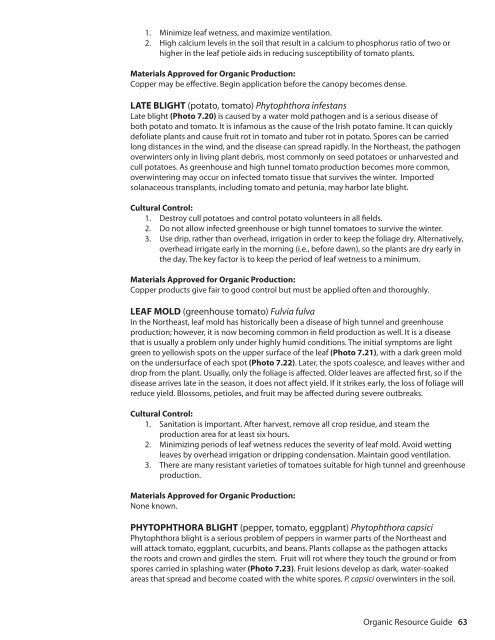Resource Guide for Organic Insect and Disease ... - Cornell University
Resource Guide for Organic Insect and Disease ... - Cornell University
Resource Guide for Organic Insect and Disease ... - Cornell University
You also want an ePaper? Increase the reach of your titles
YUMPU automatically turns print PDFs into web optimized ePapers that Google loves.
1. Minimize leaf wetness, <strong>and</strong> maximize ventilation.<br />
2. High calcium levels in the soil that result in a calcium to phosphorus ratio of two or<br />
higher in the leaf petiole aids in reducing susceptibility of tomato plants.<br />
Materials Approved <strong>for</strong> <strong>Organic</strong> Production:<br />
Copper may be effective. Begin application be<strong>for</strong>e the canopy becomes dense.<br />
LATE BLIGHT (potato, tomato) Phytophthora infestans<br />
Late blight (Photo 7.20) is caused by a water mold pathogen <strong>and</strong> is a serious disease of<br />
both potato <strong>and</strong> tomato. It is infamous as the cause of the Irish potato famine. It can quickly<br />
defoliate plants <strong>and</strong> cause fruit rot in tomato <strong>and</strong> tuber rot in potato. Spores can be carried<br />
long distances in the wind, <strong>and</strong> the disease can spread rapidly. In the Northeast, the pathogen<br />
overwinters only in living plant debris, most commonly on seed potatoes or unharvested <strong>and</strong><br />
cull potatoes. As greenhouse <strong>and</strong> high tunnel tomato production becomes more common,<br />
overwintering may occur on infected tomato tissue that survives the winter. Imported<br />
solanaceous transplants, including tomato <strong>and</strong> petunia, may harbor late blight.<br />
Cultural Control:<br />
1. Destroy cull potatoes <strong>and</strong> control potato volunteers in all fields.<br />
2. Do not allow infected greenhouse or high tunnel tomatoes to survive the winter.<br />
3. Use drip, rather than overhead, irrigation in order to keep the foliage dry. Alternatively,<br />
overhead irrigate early in the morning (i.e., be<strong>for</strong>e dawn), so the plants are dry early in<br />
the day. The key factor is to keep the period of leaf wetness to a minimum.<br />
Materials Approved <strong>for</strong> <strong>Organic</strong> Production:<br />
Copper products give fair to good control but must be applied often <strong>and</strong> thoroughly.<br />
LEAF MOLD (greenhouse tomato) Fulvia fulva<br />
In the Northeast, leaf mold has historically been a disease of high tunnel <strong>and</strong> greenhouse<br />
production; however, it is now becoming common in field production as well. It is a disease<br />
that is usually a problem only under highly humid conditions. The initial symptoms are light<br />
green to yellowish spots on the upper surface of the leaf (Photo 7.21), with a dark green mold<br />
on the undersurface of each spot (Photo 7.22). Later, the spots coalesce, <strong>and</strong> leaves wither <strong>and</strong><br />
drop from the plant. Usually, only the foliage is affected. Older leaves are affected first, so if the<br />
disease arrives late in the season, it does not affect yield. If it strikes early, the loss of foliage will<br />
reduce yield. Blossoms, petioles, <strong>and</strong> fruit may be affected during severe outbreaks.<br />
Cultural Control:<br />
1. Sanitation is important. After harvest, remove all crop residue, <strong>and</strong> steam the<br />
production area <strong>for</strong> at least six hours.<br />
2. Minimizing periods of leaf wetness reduces the severity of leaf mold. Avoid wetting<br />
leaves by overhead irrigation or dripping condensation. Maintain good ventilation.<br />
3. There are many resistant varieties of tomatoes suitable <strong>for</strong> high tunnel <strong>and</strong> greenhouse<br />
production.<br />
Materials Approved <strong>for</strong> <strong>Organic</strong> Production:<br />
None known.<br />
PHYTOPHTHORA BLIGHT (pepper, tomato, eggplant) Phytophthora capsici<br />
Phytophthora blight is a serious problem of peppers in warmer parts of the Northeast <strong>and</strong><br />
will attack tomato, eggplant, cucurbits, <strong>and</strong> beans. Plants collapse as the pathogen attacks<br />
the roots <strong>and</strong> crown <strong>and</strong> girdles the stem. Fruit will rot where they touch the ground or from<br />
spores carried in splashing water (Photo 7.23). Fruit lesions develop as dark, water-soaked<br />
areas that spread <strong>and</strong> become coated with the white spores. P. capsici overwinters in the soil.<br />
<strong>Organic</strong> <strong>Resource</strong> <strong>Guide</strong> 63







